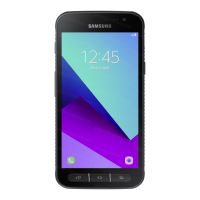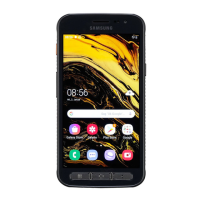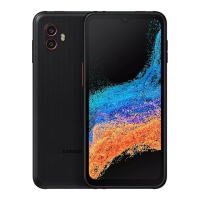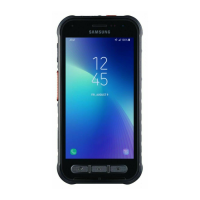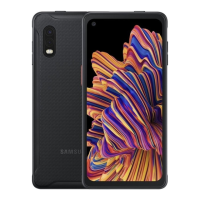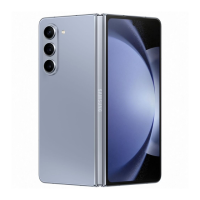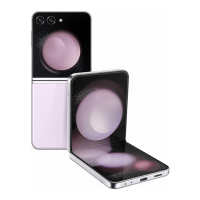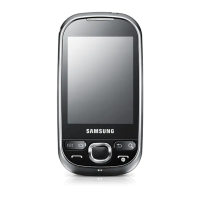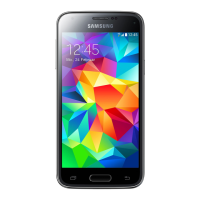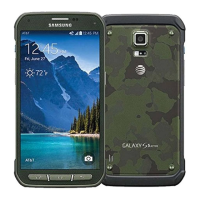Do you have a question about the Samsung Galaxy XCover 5 and is the answer not in the manual?
Provides crucial initial instructions for safe and proper device operation.
Tips and guidelines to preserve the device's water and dust resistance capabilities.
Explanation of various icons used throughout the manual for warnings and notices.
Addresses device heat during charging and provides solutions.
Explains causes of device heat during operation and offers remedies.
Advises on environmental conditions to avoid for device safety and longevity.
Details the items included in the device package and accessory information.
Identifies and labels all external physical components of the device.
Explains the functionality of physical keys and on-screen navigation buttons.
Step-by-step guide on how to safely install the device's battery.
Step-by-step guide on how to safely remove the device's battery.
Instructions and precautions for charging the device via wired and quick methods.
Tips and settings to conserve battery power and extend usage time.
Guide to inserting a nano-SIM or USIM card into the device slot.
Instructions for inserting a microSD card into the device for expanded storage.
Steps to safely remove and format memory cards for device compatibility.
Instructions for powering the device on, off, and forcing a restart.
How to activate and use emergency mode for essential functions.
Steps to follow when setting up the device for the first time.
Managing your Samsung account: sign-in, ID/password, and sign-out.
Guide to transferring data wirelessly and from a computer via Smart Switch.
How to back up and restore data using external storage devices.
Explains basic touchscreen gestures: tap, drag, swipe, pinch, and double-tap.
Details the functions of the on-screen Recents, Home, and Back buttons.
Instructions on how to hide the navigation bar for a wider screen view.
How to navigate between the main Home screen and the Apps screen.
Customizing the home screen layout, wallpaper, themes, and widgets.
Setting up patterns, PINs, or biometrics for screen security.
Explanation of common icons displayed on the device's status bar.
How to take screenshots and use capture options like scrolling capture.
How to open, view, and manage notifications and quick settings.
Activating features and adjusting settings via quick access buttons.
Managing music and video playback through the Media feature.
Explains keyboard layout, input methods, and changing languages.
Details advanced keyboard features like emoticons, GIFs, and voice input.
Step-by-step guide for copying, cutting, and pasting text efficiently.
Instructions for downloading, installing, and removing applications from stores.
How to manage app permissions for device information access.
Guide on how to initiate voice and video calls using the Phone app.
Making calls from logs, using speed dial, and international calling.
How to answer or reject incoming calls and send rejection messages.
Blocking numbers and using features during a call like mute and speaker.
How to add new contacts, import them, and sync with web accounts.
Finding, deleting, sharing contacts, and creating contact groups.
How to compose, send, and view text and voice messages.
Sorting, deleting messages, and changing notification settings.
Instructions for using the internet browser to search and bookmark pages.
How to enable and use secret mode for private browsing.
Guidelines for respectful photography and basic picture-taking.
Adjusting focus, brightness, using zoom, and various shooting modes.
Using zoom features and locking focus/exposure for better shots.
Using the camera button and available options for current shooting modes.
Using photo mode, taking selfies, and applying filters and beauty effects.
Recording videos and using manual controls in Pro mode for advanced shots.
Viewing and managing images and videos stored on the device.
How to group and preview similar photos in the Gallery application.
Selecting, viewing, modifying, and cropping images in the Gallery.
Playing videos, controlling playback, and organizing media into albums.
How to use split screen view to run two apps simultaneously.
Using the Edge panel to launch apps in split screen view.
Creating app pairs and using pop-up view for multitasking.
Managing wellness, fitness, and tracking health goals.
Creating notes and accessing customer support services.
Browsing products and information via the Galaxy Shop application.
Creating and syncing calendar events and managing reminders.
Marking reminders as complete, restoring, and deleting them.
Listening to FM radio, scanning stations, and recording audio.
Recording voice memos and managing device files.
Setting alarms, checking time, and timing events.
Performing calculations and managing games with Game Launcher.
Removing games and adjusting performance modes within Game Launcher.
Optimizing gaming performance, blocking notifications, and capturing screenshots.
Restricting access, setting usage times, and managing child's digital use.
Controlling smart appliances and IoT products with your smartphone.
Sharing content with nearby devices and setting device visibility.
Sharing files via web links and sharing Bluetooth speakers.
Listening to music together using Galaxy Buds.
Displaying device content on a larger screen like a TV or monitor.
Connecting your device to a Windows PC for data access.
Learning about global goals and sustainable development.
Overview of Google apps for entertainment, social, and business.
Overview of accessing and modifying various device settings.
Managing your Samsung account within the device settings.
Configuring Wi-Fi, Bluetooth, NFC, and flight mode.
Steps to activate and connect to a Wi-Fi network.
Viewing network quality and sharing Wi-Fi passwords.
Establishing direct device connections via Wi-Fi without an access point.
Steps to connect and pair your device with other Bluetooth devices.
Sending and receiving data files via Bluetooth connection.
Using NFC to read tags for product information.
Using NFC for contactless payments after registering a service.
Reducing data usage by limiting background app activity.
Allowing specific apps to use mobile data even on Wi-Fi.
Sharing your device's mobile data connection with other devices.
Configuring printer settings and setting up virtual private networks.
Adjusting sound modes, ringtones, notification sounds, and vibration.
Enhancing audio quality and playing app sounds separately.
Adjusting notification pop-up styles, do not disturb, and advanced settings.
Adjusting brightness, dark mode, font, screen zoom, and touch sensitivity.
Changing wallpapers and applying device themes.
Configuring the home screen layout and lock screen options.
Setting up Smart Lock and biometric security features like Face Recognition.
Managing Find My Mobile, Secure Folder, and encrypting SD cards.
Important considerations and precautions before using face recognition.
Steps for registering your face and unlocking the device.
Creating and configuring a Secure Folder for private content.
Configuring permission manager, Samsung, and Google privacy settings.
Managing app permissions for location access and accuracy.
Managing accounts, Samsung Cloud, Google Drive, and Smart Switch.
Steps to back up device data to Samsung Cloud.
How to restore backed-up data from Samsung Cloud to the device.
Activating features like Call & text on other devices, Link to Windows, and keys.
Activating and configuring motion features like lift to wake and double tap.
Managing device usage, screen time, app timers, and focus mode.
Overview of device care and automatic optimization features.
Checking battery status, power saving modes, and usage limits.
Checking storage status, deleting files, and cleaning memory.
Scanning the device for malware and checking security status.
Viewing app usage, settings, and uninstalling apps.
Customizing language, text-to-speech, date/time, and keyboard settings.
How to add and manage languages for device usage.
Configuring TalkBack, visibility, hearing, and interaction enhancements.
Downloading, installing, and viewing information about software updates.
Accessing device status, legal, software, and battery information.
Explains prompts for Password, PIN, PUK, and PIN2.
Troubleshooting poor reception and access issues.
Solutions for a device that will not power on, related to battery.
Troubleshooting slow or improper touchscreen response.
Solutions for device freezing, fatal errors, and restarting.
Performing a factory data reset to resolve persistent issues.
Troubleshooting issues with not being able to connect calls.
Troubleshooting microphone not working or sound echoes during calls.
Addressing cellular network disconnections and poor audio quality.
Solutions for battery not charging properly or depleting quickly.
Troubleshooting camera launch errors and poor picture quality.
Resolving issues with opening or playing multimedia files.
Resolving issues with Bluetooth device connection and performance.
Restoring the screen brightness slider on the notification panel.
Troubleshooting device connection problems with a computer.
Addressing issues with the device not finding its current location.
Handling data loss, insufficient storage, and missing Home button.
| Display Size | 5.3 inches |
|---|---|
| Resolution | 720 x 1480 pixels |
| Processor | Exynos 850 |
| RAM | 4GB |
| Storage | 64GB |
| Rear Camera | 16 MP |
| Front Camera | 5 MP |
| Battery Capacity | 3000 mAh |
| Operating System | Android 11 |
| Dimensions | 147.1 x 71.6 x 9.2 mm |
| Weight | 172 g |
| SIM | Single SIM (Nano-SIM) or Dual SIM (Nano-SIM, dual stand-by) |
| CPU | Octa-core (4x2.0 GHz Cortex-A55 & 4x2.0 GHz Cortex-A55) |
| GPU | Mali-G52 |
| Internal | 64GB 4GB RAM |
| Main Camera Features | LED flash, HDR, panorama |
| Main Camera Video | 1080p@30fps |
| Selfie Camera Video | 1080p@30fps |
| Loudspeaker | Yes |
| 3.5mm jack | Yes |
| WLAN | Wi-Fi 802.11 a/b/g/n/ac, dual-band, Wi-Fi Direct, hotspot |
| Bluetooth | 5.0, A2DP, LE |
| GPS | Yes, with A-GPS, GLONASS, GALILEO, BDS |
| NFC | Yes |
| Radio | FM radio |
| USB | USB Type-C 2.0 |
| Sensors | Accelerometer, proximity, compass |
| Charging | 15W wired |
| Colors | Black |
| Models | SM-G525F, SM-G525F/DS |
| Rugged Features | MIL-STD-810H compliant |
| Build | Plastic frame, plastic back |
| Chipset | Exynos 850 |
